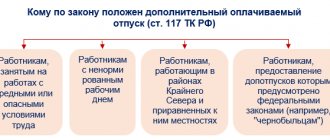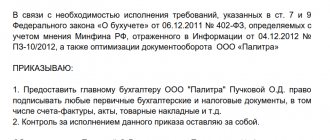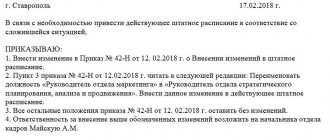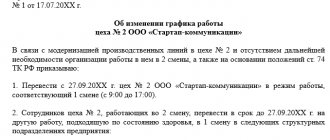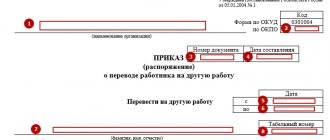There is no unified, specially developed sample order for disciplinary action. Organizations can independently develop an order template or write it in free form. To write an order, you can use the organization’s letterhead or a regular A4 sheet. The law allows the writing of a disciplinary order either by hand or in printed form, but the original signatures of the director of the organization, as well as the offending employee, must be present on it.
- Form and sample
- Online viewing
- Free download
- Safely
FILES
Before placing an order
Before issuing an order to impose a penalty, it is necessary for the offending employee to give written explanations, which should be considered by his immediate supervisor. The results of the review are included in a report, which the head of the unit passes on to higher authorities. If an employee refuses to give an explanation, this must be included in a special act.
In cases where a disciplinary violation led to injuries, accidents, etc. consequences, the organization should create a special commission to investigate the incident, since in some situations this offense may be recognized as a crime and serve as the basis for initiating a criminal case. The results of the inspection must also be reflected in the relevant act.
Thus, before writing an order for disciplinary action, it is necessary to prepare three main documents that will serve as the basis for issuing the order: an explanatory statement from the employee, a memorandum from his immediate superior and an act on the identification of the violation.
Early withdrawal of disciplinary action
Situations related to the identification of official misconduct are often ambiguous. The imposition of a disciplinary sanction in itself does not characterize a person as a person or an employee. For example, the formal absence of valid reasons does not cancel the fact of professional burnout or stress, against the background of which the violation was committed. In such cases, punishment can only aggravate the situation and demotivate. There are opposite situations, when a single punishment helps to mobilize an employee and improve his work results. In any case, the duration of the disciplinary sanction is one year (Article 194 of the Labor Code of the Russian Federation). However, the employer has the opportunity to take an individual approach and lift the disciplinary sanction ahead of schedule, either on its own initiative or at the request of the employee or his immediate supervisor (Article 194 of the Labor Code of the Russian Federation). After the expiration of a year from the date of prosecution, it is removed automatically.
Sample order to remove foreclosure
How to place an order correctly
The order on the responsible person has a completely standard structure. It must contain information about the legal entity in which the employee who was subject to the penalty works and his personal data. It should also indicate the reason for the penalty, indicate the punishment, and provide links to the documents that served as the basis for the issuance of this document.
The legislation establishes three options for penalties:
- dismissal;
- disciplinary reprimand;
- Just a simple note.
Any other methods of collection will be unlawful. The form of punishment is determined by the head of the organization, depending on the employee’s explanations and the severity of his offense.
It is also important to remember that only one type of penalty can be imposed for one violation.
What types of disciplinary sanctions exist?
The Labor Code of the Russian Federation gives the employer the right to apply the following types of disciplinary sanctions:
- Comment.
- Rebuke.
- Dismissal on appropriate grounds (Article 192 of the Labor Code of the Russian Federation).
Often, personnel workers mistakenly believe that this formulation of the law means ranking punitive measures according to the degree of severity and chronology of application. In fact, labor legislation does not contain such instructions, nor does it provide clear definitions of these concepts. Consequently, the employer has the right, at his own discretion, to choose the type of punishment within the framework of the law. It is important to remember that Art. 193 of the Labor Code of the Russian Federation allows you to impose only one punishment for one disciplinary violation.
Instructions for writing a disciplinary order
- At the beginning of the document, the full name of the legal entity is written, indicating its organizational and legal form (CJSC, OJSC, LLC, individual entrepreneur). Then the word “Order” is written, its number according to internal document flow is indicated and the essence of the document is briefly indicated.
- In the line below you should enter the locality in which the organization is located, as well as the date the order was filled out (day, month (in words), year).
- Next, you need to provide detailed information about the essence of the claim against the employee, in other words, the reason for imposing the penalty. Here you should enter his last name and first name. patronymic (first name and patronymic can be in the form of initials), date of the identified violation.
- After this, you need to enter the word “I order” and enter the appropriate order (to reprimand, make a reprimand or dismiss the employee). Below are the reasons for issuing the order (memorandum, explanatory note, act, etc.).
- Finally, the order must be signed by the management team: the director of the enterprise, the head of the structural unit, the person responsible for personnel. The offending employee must also sign the order.
If desired, the order can be certified with a seal, but since 2016, legal entities do not have to have a seal. If the enterprise has a trade union body, then it must also be marked.
What is considered non-compliance with labor discipline
Labor Code of the Russian Federation in Art. 189 defines the concept of labor discipline - these are the rules that every employee must follow while at the workplace. They are contained in the Labor Code of the Russian Federation, the employment contract, internal labor regulations, job descriptions, etc.
If an employee does not comply with the rules adopted by the organization, such behavior is improper performance of job duties and neglect of labor discipline.
The most common types of misconduct:
- showing up at work while intoxicated;
- being late without a good reason;
- failure to fulfill official duties;
- failure to comply with occupational health and safety requirements;
- damage to the employer's property and other unlawful actions.
For failure to comply with labor discipline, the employer has the right to reprimand, reprimand or dismiss (Article 81 of the Labor Code of the Russian Federation).
Results
Drawing up a document recording the fact of violation of labor discipline is one of the most important stages in the procedure for applying punishment to the offending employee. Therefore, it is necessary to pay special attention to the timeliness and correctness of its execution.
What types of penalties can be applied to employees who violate discipline, and whether a fine can be such a penalty, find out from this article.
You can find more complete information on the topic in ConsultantPlus. Free trial access to the system for 2 days.
Who draws up the act
The act can be written by any employee of the company authorized to create such documents by order of the director or provisions prescribed in the job description. Most often this is:
- the head of the structural unit in which the offender works;
- legal advisor;
- HR specialist, etc.
At the same time, witnesses or a specially created commission must be involved in the formation of the act. It may include employees of the enterprise, consisting of at least three people.
Types of labor discipline violations
It is believed that there are three types of misconduct:
- insubordination to superiors or insubordination (administrative);
- refusal or inability to comply with labor standards (technical);
- neglect of the work and rest schedule (regime).
And if with administrative and regime violations everything is more or less clear: he committed an offense, did not provide any explanation, the management drew up an act, and then punishment followed, then with technical violations the situation is somewhat more complicated.
The fact is that a violation of labor standards must not only be recorded, but also made sure that it was committed due to the employee, and not, for example, outdated or broken equipment.
In order to avoid an unlawfully imposed penalty, employees of enterprises dealing with complex equipment are obliged to promptly report to their superiors in reports about its breakdowns and defects - otherwise, an act of violation of labor discipline may be applied to them.
How to create an order
The legislator has not defined the form of an order to punish an employee for individual entrepreneurs or legal entities of other forms of ownership. The general situation is this:
- if the penalty is a reprimand or reprimand, then the order is drawn up in any form;
- if the sanction is dismissal, then the document is issued according to the unified form T-8 (approved by the Resolution of the State Statistics Committee of Russia dated January 5, 2004) or an independently developed form.
The order reflects the following information:
- Full name of the employee;
- job title;
- the structural unit where the employee works;
- describe the violation, indicate documents confirming the fact, violated provisions of the contract, instructions, norms containing provisions of labor law, including local acts of the employer;
- the circumstances of the violation, the severity and guilt of the employee;
- type of punishment;
- basis for issuing a local act (details of the document in which the offense is recorded).
Here is what a sample order to punish an employee for a violation looks like:
| STATE BUDGETARY EDUCATIONAL INSTITUTION FOR ADDITIONAL CHILDREN’S EDUCATION SPECIALIZED CHILDREN AND YOUTH SPORTS SCHOOL OF OLYMPIC RESERVE “ALLUR” (GBOU DOD SDYUSSHOR "ALLUR") Order No. 7 about disciplinary action in the form of a reprimand Moscow May 27, 2022 Due to the absence of riding coach P.P. Petrov from work. 05/11/2020 from 10:00 to 13:00 and the injury received during this period by student Sazonov S.S. (dislocation of the arm joint) I ORDER: Reprimand the riding coach P.P. Petrov. Base: — memo from the head of the riding department, Anisimova A.A. from 12.05. 2020; - medical report on the injury of Sazonov S.S. dated May 11, 2020. Director ____________________ Ivanov I.I. Head of the riding department ____________________ Anisimova A.A. The employee is familiar with the order ______________________ Petrov P.P. "___"__________2020 |
Who makes it up
Most often, it is drawn up by a HR specialist or the employer himself.
Witnesses from among the enterprise’s employees, at least two people, must be involved in the preparation, who, with their signatures at the end of the document, confirm the correctness of the specified information.
There is no single unified form. Therefore, the form of the act of violation of labor discipline is arbitrary. When compiling it, the employer can use the organization’s letterhead.
It should indicate:
- date, time, place of document preparation;
- type of document (act);
- name of company;
- position and full name directors of the company;
- position and full name witnesses in whose presence the act is drawn up;
- position and full name the offending employee;
- description of the violation committed;
- application (for example, an explanatory note from an employee).
The document must be signed by the originator (the head of the enterprise), the employees present when it was written, and the guilty employee. If he refuses to sign, a separate entry should be made about this.
conclusions
The initial stage of bringing an employee to disciplinary liability is drawing up an act of misconduct. An employee whose authority includes filling out papers of the specified type has the right to draw up a document of this nature.
The act of disciplinary offense is a documentary confirmation of the fact of its commission. On its basis, an order is issued, in accordance with which the type of disciplinary sanction applied to the offending employee is determined - a reprimand, reprimand or dismissal.
Another document has a similar purpose - a memo. The order of its design has its own distinctive features.
